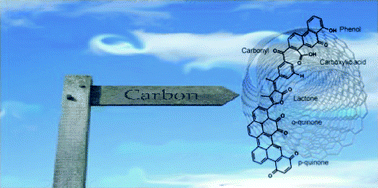Characterising chemical functionality on carbon surfaces
Abstract
This feature article introduces the reader to the surface chemistry and structure of graphitic carbon materials, including

* Corresponding authors
a
Department of Chemistry, Physical and Theoretical Chemistry Laboratory, University of Oxford, South Parks Road, Oxford, United Kingdom
E-mail:
gregory.wildgoose@chem.ox.ac.uk, richard.compton@chem.ox.ac.uk
Fax: +44 (0)1865 275410
Tel: +44 (0)1865 275413
This feature article introduces the reader to the surface chemistry and structure of graphitic carbon materials, including

 Please wait while we load your content...
Something went wrong. Try again?
Please wait while we load your content...
Something went wrong. Try again?
G. G. Wildgoose, P. Abiman and R. G. Compton, J. Mater. Chem., 2009, 19, 4875 DOI: 10.1039/B821027F
To request permission to reproduce material from this article, please go to the Copyright Clearance Center request page.
If you are an author contributing to an RSC publication, you do not need to request permission provided correct acknowledgement is given.
If you are the author of this article, you do not need to request permission to reproduce figures and diagrams provided correct acknowledgement is given. If you want to reproduce the whole article in a third-party publication (excluding your thesis/dissertation for which permission is not required) please go to the Copyright Clearance Center request page.
Read more about how to correctly acknowledge RSC content.
 Fetching data from CrossRef.
Fetching data from CrossRef.
This may take some time to load.
Loading related content
